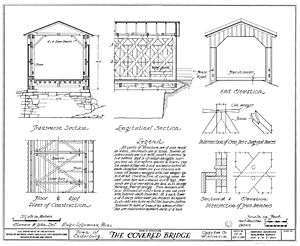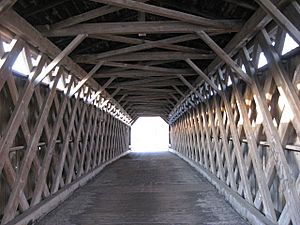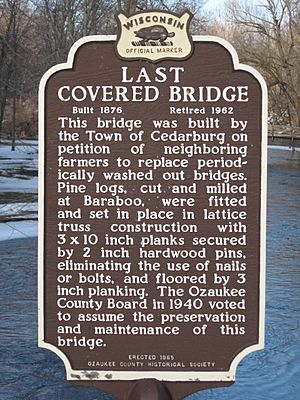Covered Bridge (Cedarburg, Wisconsin) facts for kids
Quick facts for kids |
|
|
Covered Bridge
|
|
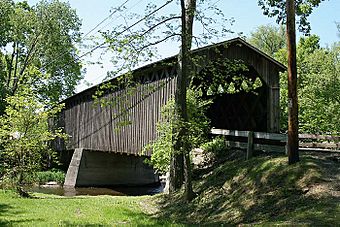
Covered Bridge in May 2009
|
|
| Nearest city | Cedarburg, Wisconsin |
|---|---|
| Area | Less than 1 acre (0.40 ha) |
| Built | 1876 |
| Architectural style | Latticed timber truss |
| NRHP reference No. | 73000092 |
| Added to NRHP | March 14, 1973 |
The Covered Bridge in Cedarburg, Ozaukee County, Wisconsin, is a special landmark. It was first called the Red Bridge. This bridge is one of the very few covered bridges left in Wisconsin. Long ago, Wisconsin had about 40 covered bridges.
This historic bridge was built in 1876. It crosses over Cedar Creek. The bridge is 120 feet (about 36 meters) long. It is made from strong pine wood with oak criss-cross patterns. In 1973, it was added to the National Register of Historic Places. Today, only people walking can use the bridge.
History of the Covered Bridge
The Covered Bridge was built in 1876. Local farmers asked for it to be built. It was meant to be a strong, lasting bridge. Before this, other bridges in the area kept washing away.
In 1927, a new support was added under the bridge's middle. This helped it hold heavier vehicles like cars and trucks. These vehicles were not around when the bridge was first built.
In 1940, the Ozaukee County Board started taking care of the bridge. They made sure it stayed in good condition.
By 1960, Ozaukee County bought the bridge and the land around it. They paid $7,500 for it. This area then became the Covered Bridge County Park.
After almost 100 years, the bridge started to wear out. Heavy traffic made its wooden planks loose. To save the bridge, they decided to move it. In 1962, the Park Commission moved the bridge about 50 feet (about 15 meters) east.
It was then decided that only people walking could use the old bridge. A new, modern bridge was built right next to it. This new bridge is now used for cars on Covered Bridge Road. The original Covered Bridge was officially listed on the National Register of Historic Places on March 14, 1973.
In 2009, the county planned to spend over $19,000 on the park. Some of this money was for new wood for the bridge's deck and railings.
How the Bridge Was Built
The Covered Bridge sits over Cedarburg Creek. It runs from north to south. It is a special type of bridge called a timber lattice truss bridge. It was originally 120 feet (about 36 meters) long. The bridge is 17 feet (about 5 meters) wide. Its roof is about 18 feet (about 5.5 meters) high from the ground supports. Inside, from the floor to the roof supports, it's about 13 feet (about 4 meters) high.
The bridge was built using strong oak and pine wood. This wood came from near Baraboo, Wisconsin. The criss-cross patterns, called lattices, are very large. They are made of oak. What's cool is that they were put together without any bolts or nails!
Instead, the main support beams are held together with round oak pegs. These pegs are 2 inches (about 5 cm) wide. The side and end boards are 1 inch (about 2.5 cm) thick and 12 inches (about 30 cm) wide. Smaller boards cover the joints. There are also diagonal supports that fit into cross beams. These are held tight with small oak wedges.
The roof is covered with cedar shingles. These shingles are placed over wooden rafters. The main cross beams at the floor are also strongly connected.
The floor itself is made of thick wooden joists. These are covered with wood planks laid on their sides. Inside the bridge, there's a protective wooden guard. It's about one foot (30 cm) above the floor. This guard protected the walls from wagon wheels.
The supports at each end of the bridge are made of fieldstone. These stones are held together with white mortar. They are 17 feet (about 5 meters) wide where they meet the bridge. They get wider towards the ground, reaching about 18 feet (about 5.5 meters). The support in the middle was also fieldstone at first. But before 1937, it was changed to concrete.
Signs and Markers
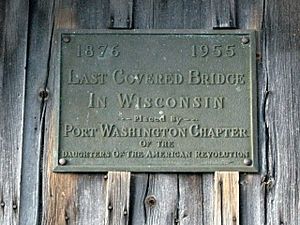
The bridge has a special plaque on it. The Port Washington Chapter of the Daughters of the American Revolution placed it there in 1955. It says the bridge is the "last covered bridge in Wisconsin." It also shows the years 1876 and 1955.
In 1965, another historical marker was put in front of the bridge. The Ozaukee County Historical Society put it up. This sign also calls it the "Last Covered Bridge." It says it was built in 1876 and "retired" in 1962. This means it stopped being used for cars.
A Similar Bridge
A copy of the Covered Bridge was built in 1997. It is called the Springwater Volunteer Bridge. You can find it in Waushara County, Wisconsin.





